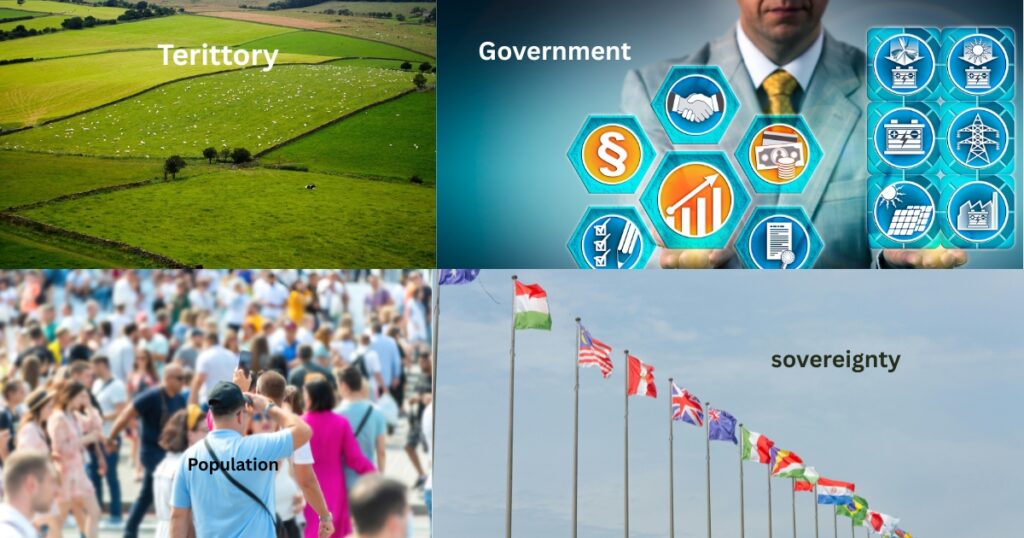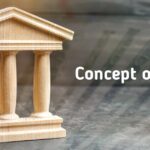Learn the concept of state in Political Science, definitions, essential elements, major theories, and its relevance in the modern world.
Why Understanding the Concept of State Matters: From the moment we are born, we live under the umbrella of some form of state, a structured political authority that governs our daily lives, protects our rights, and enforces our duties. Whether you are voting in an election, paying taxes, enjoying public parks, or benefiting from state-sponsored healthcare, the state plays a powerful yet often invisible role.
Understanding the concept of the state is essential for Political Science students, policymakers, and informed citizens because it is the foundation upon which modern governance, law, and international relations are built. In this post, we examine what the state is, its essential elements, its nature, the major theories of its origin, and its role in today’s interconnected world.
Meaning and Definition of the State:
Origin of the Term “State”
The word State derives from the Latin word status or statum, meaning “standing” or “condition.” The term gained prominence during the Renaissance when Niccolò Machiavelli, in his work “The Prince” (1532), used the Italian term Lo Stato to describe the political authority that governs a territory.
Over time, the term evolved to signify the organized political community under one government.
Definitions:
Political thinkers and scholars have offered multiple definitions:
Aristotle: Described the state as a “union of families and villages having for its end a perfect and self-sufficing life.”
Max Weber: Defined the state as “a human community that successfully claims the monopoly of the legitimate use of physical force within a given territory.”
Woodrow Wilson: Called the state “a people organized for law within a definite territory.”
Key distinction:
The state is not the same as the government. The government is the machinery through which the state operates, but the state includes the people, territory, sovereignty, and governance system as a whole.
Elements of the State:

1. Territory:
i) A fixed geographical area with recognized boundaries:
A state must have a clearly defined territory that is recognized by other states and international bodies.
These boundaries mark where its authority begins and ends, ensuring legal and administrative control.
For example, France has well-defined borders with countries like Germany, Italy, and Spain, recognized globally. Disputed or unclear boundaries can weaken a state’s control and stability.
ii) Can include land, water, airspace, and subsoil:
Territory is not limited to the land surface; it extends to internal waters (rivers, lakes), territorial seas (up to 12 nautical miles), the airspace above the land and waters, and the subsoil containing minerals and resources.
For instance, Saudi Arabia’s oil-rich subsoil forms the basis of its economic strength, while Singapore exercises full control over its territorial airspace to protect national security.
iii) Disputes over territory can challenge sovereignty:
Territorial disputes often lead to political tension, military conflict, or prolonged diplomatic struggles. Such disputes can undermine a state’s sovereignty and stability.
For example, the Kashmir conflict between India and Pakistan has persisted since 1947, involving wars and ongoing diplomatic negotiations.
Similarly, the South China Sea dispute sees multiple countries, including China, Vietnam, and the Philippines, claiming overlapping maritime zones due to their strategic and economic value.
2. Population:
i) The state must have people, citizens who owe allegiance and are protected by it:
A state cannot exist without people, as they form the foundation of its political, economic, and social life.
Citizens owe loyalty to the state in return for the protection of their rights and freedoms. For example, in the United States, citizens enjoy constitutional rights while fulfilling duties like paying taxes and obeying laws.
Without a population, a state would merely be a piece of land without political identity or authority.
ii) The size can range from small: (Monaco) to large (India, USA)
States vary greatly in population size. Monaco, with about 39,000 residents, is one of the smallest yet enjoys high economic prosperity.
On the other hand, India and the United States have populations in the hundreds of millions, influencing their political power, economic markets, and global influence.
Both small and large states can thrive if they effectively manage resources and governance structures.
iii) Diversity in culture, ethnicity, and language can influence political stability:
Cultural, ethnic, and linguistic diversity can be a source of strength or tension for a state.
In India, over 2,000 distinct ethnic groups and 22 official languages enrich its cultural fabric, but also require strong institutions to maintain unity.
In contrast, unresolved ethnic divisions, such as those in Sudan before its split into Sudan and South Sudan, can lead to conflict and instability.
3. Government:
i) The organization through which political authority is exercised:
The government is the structured institution through which a state’s political power is organized, expressed, and implemented.
It acts as the decision-making body that represents the state in both domestic and international affairs. For example, in Canada, the federal government manages national defense, foreign policy, and economic regulations on behalf of the entire country.
Without a government, the state would lack direction and the ability to enforce policies.
ii) Can take various forms: democracy, monarchy, dictatorship, etc.
Governments can exist in different systems depending on how power is distributed and exercised. In a democracy like India, leaders are elected by the people.
A monarchy, such as in the United Kingdom, retains a royal family alongside elected officials. In a dictatorship, like North Korea, power is concentrated in the hands of one leader or a small group, often without free elections.
Each form influences how citizens participate in governance and how rights are protected.
iii) Responsible for law-making, law enforcement, and administration:
The government’s key functions include making laws (legislative role), enforcing those laws (executive role), and managing the administration of public services (bureaucratic role).
For instance, in the United States, Congress passes laws, the President and federal agencies enforce them, and administrative bodies handle everyday governance tasks like education, transportation, and public health.
This division ensures the state operates effectively and maintains order.
4. Sovereignty:
i) The supreme authority of the state to govern itself without external interference:
Sovereignty means that a state has ultimate power over its internal affairs and decisions, free from outside control.
This authority allows the state to create its own laws, policies, and governance structures. For example, Japan decides its domestic policies without any foreign government dictating terms, which is a key mark of its sovereignty. Loss of sovereignty, as seen in colonial rule, often leads to political and social unrest.
ii) Internal sovereignty: Authority over people and territory within borders:
Internal sovereignty refers to the state’s absolute power to govern its citizens and manage resources within its boundaries.
It ensures that laws apply equally to everyone inside the territory. For instance, France has the right to enforce its laws across Paris, Marseille, and all regions within its recognized borders, regardless of external opinions. Without internal sovereignty, law and order would be impossible to maintain.
iii) External sovereignty: Independence from control by other states:
External sovereignty is the state’s freedom to conduct foreign relations and make decisions without interference from other nations.
It means being recognized as an independent entity in the international community. For example, Switzerland maintains external sovereignty by deciding its foreign policies, trade agreements, and defense strategies independently.
When external sovereignty is violated, such as during military occupation, the state’s independence is compromised.
Nature of the State:

The state can be understood from various perspectives:
1. Legal Perspective
From the legal standpoint, the state is a juridical (legal) entity recognized by international law. This means it possesses defined rights, such as sovereignty over its territory, and obligations, such as respecting the sovereignty of other states.
It can enter into treaties, sign agreements, and be a party in international disputes. For example, India, as a recognized sovereign state, is a member of the United Nations and signs treaties like the Paris Climate Agreement.
Legally, the state’s authority to make, enforce, and interpret laws gives it a structured and binding presence in the global legal system.
2. Political Perspective
Politically, the state is the supreme authority in society, controlling and distributing power among individuals, groups, and institutions.
It decides “who gets what, when, and how,” as famously defined by political scientist Harold Lasswell. For example, in the United States, the political system determines how resources are allocated, how elections are conducted, and how laws are implemented, ensuring stability and order.
This perspective emphasizes the state’s role in managing political power and preventing chaos through structured governance.
3. Sociological Perspective
From the sociological view, the state is seen as a product of social evolution, emerging over centuries from human needs for security, order, and cooperation.
It reflects a society’s cultural values, traditions, and economic structures. For instance, the Nordic states (like Sweden and Norway) have welfare-oriented policies because their social norms value equality and collective welfare.
In contrast, the state in ancient Sparta was shaped by militaristic traditions. This perspective highlights that the state is not just a political machine, but also a living institution shaped by the people’s way of life.
Major Theories on the Origin of the State:
1. Divine Origin Theory:
This theory asserts that the state was created by God, and rulers are divinely appointed to govern. According to this belief, the king or monarch acts as God’s representative on Earth, and obeying the ruler is equivalent to obeying God’s will.
This idea was widely accepted in Medieval Europe, where monarchs like Louis XIV of France claimed to rule by “divine right.” Similarly, ancient civilizations such as Egypt viewed their pharaohs as gods or semi-divine beings.
While the theory reinforced the authority of rulers, it is heavily criticized for lacking scientific evidence and for justifying absolute, unquestionable power.
2. Social Contract Theory:
This theory suggests that the state emerged through a voluntary agreement (contract) among individuals to escape a chaotic “state of nature” and establish organized governance. Several influential thinkers shaped this idea:
Thomas Hobbes (Leviathan, 1651): Believed humans are naturally selfish and violent, so they need a strong ruler to prevent anarchy.
John Locke: Emphasized that the state should protect natural rights (life, liberty, property) and that government must be limited and accountable.
Jean-Jacques Rousseau: Advocated popular sovereignty, where political power rests with the people.
A real-world example is the U.S. Constitution, which reflects social contract principles by outlining citizen rights and limiting government powers.
3. Force Theory:
According to the Force Theory, the state originated through conquest and coercion. One group or leader, using physical force, subjugated others and established political authority.
This theory explains the rise of many ancient empires, such as the Roman Empire and the Mongol Empire, which expanded through military conquest and maintained control through power and fear.
While effective in creating centralized authority quickly, states formed through force often faced resistance and instability when the use of power was excessive.
4. Evolutionary Theory:
The Evolutionary Theory holds that the state developed gradually over time, beginning with small social units like families, which grew into clans, then tribes, and eventually organized political communities.
This process was driven by human needs for cooperation, security, and resource management. For example, Ancient Mesopotamia evolved from agricultural settlements into complex city-states with governance systems.
This theory is supported by historical anthropology and archaeology, showing that states emerged naturally as societies became more complex.
Functions of the State:

Protective Functions:
1. Maintaining law and order:
The state is responsible for ensuring peace and stability within its territory by enforcing laws and preventing crime.
Police forces, legal systems, and regulatory agencies work to uphold societal norms and protect citizens from harm. For example, Singapore’s strict law enforcement has contributed to its low crime rate and social order.
2. Protecting the nation from external threats (defense)
Defense is a core function of the state, involving military forces to deter or repel foreign aggression. This ensures the security of the nation’s borders and sovereignty.
For instance, Israel’s defense policies are designed to protect against potential threats from neighboring regions, safeguarding its independence.
3. Upholding justice through courts:
The judicial system ensures fairness by interpreting laws and resolving disputes. Courts protect individual rights and hold both citizens and the state accountable.
For example, the Supreme Court of the United States can overturn laws that violate the Constitution, ensuring justice and the rule of law.
Welfare Functions
1. Providing education, healthcare, and social security
The state invests in public education systems, healthcare facilities, and social programs to improve citizens’ quality of life.
For instance, Finland’s education system and Norway’s universal healthcare are models of how welfare policies can support societal well-being.
2. Ensuring economic equality and opportunity
Through taxation, subsidies, and affirmative action, the state works to reduce wealth gaps and create equal opportunities.
For example, Sweden’s progressive taxation funds public services and minimizes income inequality, promoting social stability.
Developmental Functions:
1. Promoting infrastructure, trade, and technology
The state plays a role in building roads, bridges, ports, and communication networks to boost economic growth. It also promotes trade policies and invests in technological innovation.
For example, China’s Belt and Road Initiative is aimed at improving infrastructure and fostering trade connections worldwide.
2. Managing resources for sustainable growth
Sustainable resource management ensures that natural wealth is preserved for future generations. This includes environmental regulations, renewable energy programs, and conservation projects.
For example, Costa Rica has committed to renewable energy and forest preservation, making it a global leader in sustainable development.
Relevance of the State in the Modern World:
1. Globalization
In the 21st century, globalization has interconnected economies, cultures, and political systems, leading to shared governance between states and international organizations such as the United Nations (UN), European Union (EU), and World Trade Organization (WTO).
While states remain the primary authority over their territories, they increasingly collaborate on issues like climate change, trade regulations, and human rights.
For example, EU member states coordinate economic policies and laws for collective benefit, showing how sovereignty can be partially shared without erasing national identity.
2. Failed States
Some states struggle to fulfill their basic functions, becoming what political scientists call “failed states.” These nations face collapsed governance, weak institutions, and an inability to protect citizens or enforce laws.
For example, Somalia has endured decades of instability due to internal conflict and lack of central authority, while Yemen faces humanitarian crises worsened by civil war.
Such cases highlight the continuing importance of strong, functional state structures in ensuring peace and security.
3. Stateless Nations Seeking Recognition
A stateless nation refers to a group of people who share a common identity but lack a recognized sovereign state.
For example, Palestine continues to seek international recognition and independence while facing territorial and political disputes. Stateless nations challenge the traditional state system by demanding self-determination, often leading to diplomatic debates and geopolitical tensions.
4. Rise of Digital Governance and Cybersecurity Concerns
The digital revolution is reshaping how states operate, from online citizen services to national cybersecurity policies.
Estonia’s e-governance model is a leading example, allowing citizens to vote, pay taxes, and access public services entirely online.
However, this digital shift also introduces challenges like cyberattacks, data privacy concerns, and the need for new forms of digital law enforcement.
The modern state must now protect not only its physical territory but also its digital infrastructure.
Conclusion:
The state has journeyed from ancient monarchies to modern democracies, adapting to social, economic, and technological changes.
It remains the backbone of political organization and a key player in solving both domestic and global issues.
Understanding the state’s concept is not merely an academic exercise — it is the key to understanding the very framework within which we live our lives.
You Can Read: Meaning, Nature, and Scope of Political Science
FAQs:
1. What is the definition of a state in political science?
A state is a political entity with a defined territory, a permanent population, a government, and sovereignty, recognized both internally and externally.
2. What are the essential elements of a state?
The four essential elements are territory, population, government, and sovereignty. Without any one of these, a state cannot legally exist.
3. How is a state different from a nation?
A state is a political and legal entity, while a nation refers to a group of people with shared identity, culture, and history. A nation may exist without being a state (e.g., the Kurds).
4. What is meant by sovereignty?
Sovereignty is the state’s supreme authority to govern itself without external interference. It can be internal (control over its people and territory) or external (independence from other states).
5. What are the major theories on the origin of the state?
Theories include the Divine Origin Theory, Social Contract Theory, Force Theory, and Evolutionary Theory, each offering a different explanation for how states emerged.
6. Why is the state still relevant in the era of globalization?
Despite globalization, states remain central to governance, identity, and law. They work alongside international organizations but still maintain primary control over their citizens and territory.
7. What is the role of the state in protecting its citizens?
The state ensures law and order, defends against external threats, and upholds justice through a functioning legal system.
8. How does the state promote welfare?
Welfare functions include providing education, healthcare, social security, and ensuring economic equality and opportunity.
9. What challenges do modern states face?
Challenges include failed governance in some states, demands from stateless nations, adapting to digital governance, and protecting against cybersecurity threats.
10. Can a state exist without international recognition?
A state can function internally without recognition, but lack of recognition limits its ability to participate in international relations. For example, Taiwan operates as a state but is not universally recognized.










